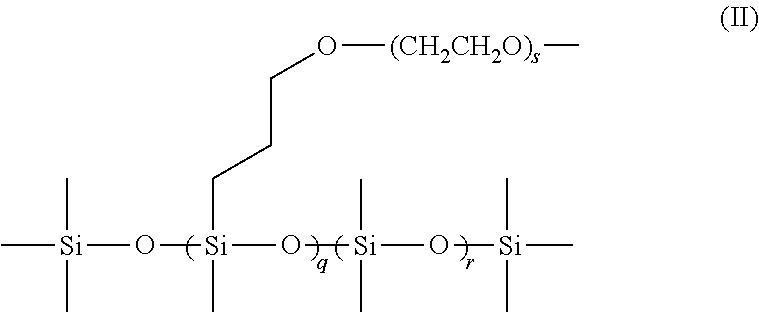Silicone copolymers as emulsification additives for quantum dot resin premix
a technology of quantum dots and additives, applied in the field of quantum dots compositions, can solve the problems of affecting the curing properties of the final quantum dot composite, and delivering quantum dots in solvents to end-users who wish to further process the quantum dots
- Summary
- Abstract
- Description
- Claims
- Application Information
AI Technical Summary
Benefits of technology
Problems solved by technology
Method used
Image
Examples
example 1
[0297]Photocurable Quantum Dot-Resin Formulation without Emulsification Additive
[0298]Pentaerythritol tetrakis (3-mercaptopriopionate) (6.67 g) (Evans Chemetics LP, Teaneck, N.J.), Trimethylolpropane tris(3-mercaptopriopionate) (26.67 g) (Evans Chemetics LP, Teaneck, N.J.), Triallyl triazine trione (26.67 g) (Sartomer USA, Exton, Pa.), and IRGACURE® TPO-L (0.6 g) (BASF Corporation, Wyandotte, Mich.) are mixed for 2 minutes in a planetary vacuum mixer at 2000 rpm.
[0299]Afterwards, aminosilicone-based Green Quantum Dot Concentrate (Nanosys, Milpitas, Calif.) (3.24 g) and aminosilicone-based Red Quantum Dot Concentrate (Nanosys, Milpitas, Calif.) (0.85 g) are added and the mixture is again mixed for 2 minutes in a planetary vacuum mixer at 2000 rpm.
example 2
[0300]Photocurable Quantum Dot-Resin Formulation with Emulsification Additive 1
[0301]To a portion of the mixture from Example 1 (6.0 g) is added the silicone copolymer emulsification additive BYK-UV 3510 (0.09 g) (BYK Additives and Instruments, Germany). The mixture is again mixed for 2 minutes in a planetary vacuum mixer at 2000 rpm.
example 3
[0302]Photocurable Quantum Dot-Resin Formulation with Emulsification Additive 2
[0303]To a portion of the mixture from Example 1 (6.0 g) is added the silicone copolymer emulsification additive GP-675 (0.09 g) (Genesee Polymers, Flint, Mich.) The mixture is again mixed for 2 minutes in a planetary vacuum mixer at 2000 rpm.
PUM
| Property | Measurement | Unit |
|---|---|---|
| time | aaaaa | aaaaa |
| sizes | aaaaa | aaaaa |
| sizes | aaaaa | aaaaa |
Abstract
Description
Claims
Application Information
 Login to View More
Login to View More - R&D
- Intellectual Property
- Life Sciences
- Materials
- Tech Scout
- Unparalleled Data Quality
- Higher Quality Content
- 60% Fewer Hallucinations
Browse by: Latest US Patents, China's latest patents, Technical Efficacy Thesaurus, Application Domain, Technology Topic, Popular Technical Reports.
© 2025 PatSnap. All rights reserved.Legal|Privacy policy|Modern Slavery Act Transparency Statement|Sitemap|About US| Contact US: help@patsnap.com



